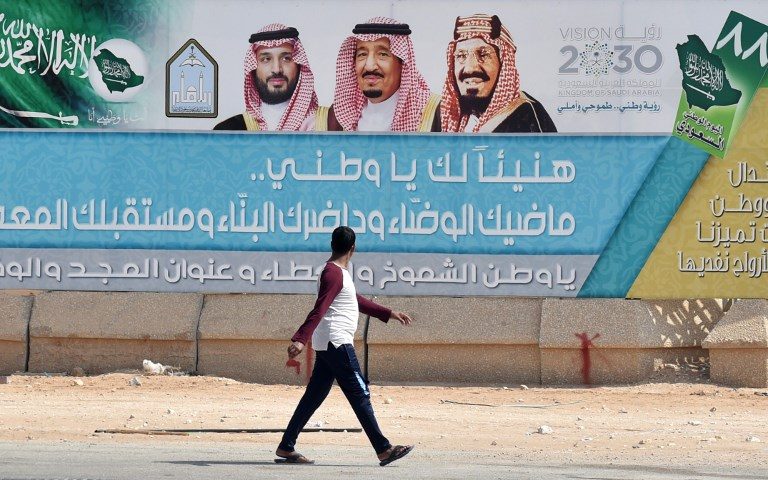SUMMARY
This is AI generated summarization, which may have errors. For context, always refer to the full article.

DUBAI, United Arab Emirates – Mohammed bin Salman became crown prince of Saudi Arabia in June last year, shaking up the ultra-conservative oil giant with economic, social and religious reforms.
But his tenure has also brought a crackdown on political dissent.
Here is a rundown of developments:
Crown prince at 31
On June 21, 2017, King Salman names his 31-year-old son, Mohammed, as crown prince, displacing the king’s nephew Prince Mohammed bin Nayef as heir to the throne.
Widely known as MBS, Prince Mohammed retains his role as defense minister. The appointment caps a meteoric rise.
It comes amid a major fallout with Qatar: Riyadh and regional allies sever ties with Doha the same month, accusing it of supporting “terrorists” and being too close to Saudi Arabia’s arch-rival Iran. Qatar denies the charges.
Royal purge
In September 2017, authorities round up at least 20 people, including influential clerics and intellectuals, in what is condemned as a crackdown on dissent orchestrated by the crown prince.
Around 380 royals, ministers and business tycoons are then arrested in November in a dramatic purge led by Prince Mohammed that the government says is a move against corruption.
Many are held for weeks in the Riyadh Ritz-Carlton Hotel. Most are released after agreeing significant financial settlements.
Reforms
The monarchy ends the world’s only ban on female drivers by announcing in September 2017 that they will be able to take the wheel from June 2018.
The decision is part of a vast modernization plan for the country inspired by the prince as he looks to bolster foreign investment. (READ: First Saudi women get driving licenses)
In the same spirit, cinemas are reopened, music concerts organized with mixed-gender audiences permitted, and women allowed into sports stadiums.
But the enthusiasm generated by the announcements of reforms is tarnished by repression of female activists who long opposed the driving ban.
Prince Mohammed is also the architect of a wide-ranging plan for social and economic change, called Vision 2030, that is approved before his appointment as crown prince.
Lebanon crisis
In November 2017, Lebanese Prime Minister Saad Hariri announces in a televised address from Riyadh that he is resigning, citing Iran’s “grip” on his country.
Saudi Arabia is accused of forcing his hand to make a stand against the influence of Iran and its ally in Lebanon, Hezbollah.
Hariri, supported by Saudi Arabia for years, spends two weeks in Riyadh amid speculation he is being kept under house arrest. France intervenes and he withdraws his resignation after arriving back in Lebanon.
Yemen war
Riyadh entered the Yemeni conflict in 2015 at the head of an Arab military coalition supporting the government against the Iran-aligned Huthi rebels.
The crown prince in November 2017 accuses Iran of “direct military aggression” by supplying ballistic missiles to rebels in neighboring Yemen.
Days before, Saudi forces intercepted a ballistic missile near Riyadh international airport that was fired by the rebels.
Nuclear Iran
Prince Mohammed says in March 2018 that if Iran develops a nuclear weapon, Riyadh will do so too.
In an interview with CBS television, he likens the territorial ambitions of Iran’s supreme leader Ayatollah Ali Khamenei to those of Adolf Hitler in Nazi Germany.
Riyadh holds deep reservations over the 2015 accord aimed at curbing Iran’s nuclear ambitions and hails President Donald Trump’s announcement in May 2018 that the United States is withdrawing from the deal.
Charm offensive
In March 2018, the prince embarks on his first foreign tour as heir, visiting Egypt and Britain – where he lunches with Queen Elizabeth II.
Prince Mohammed then spends two weeks in the US, meeting Trump and other political and economic leaders. He also goes to France and Spain.
Journalist killed
The disappearance of Saudi journalist Jamal Khashoggi, who goes missing after entering the kingdom’s Istanbul consulate on October 2, unleashes an international crisis.
Turkish officials say they believe Khashoggi, who was critical of Prince Mohammed, was killed inside the consulate by a hit squad.
After initially denying the claims as “baseless”, Riyadh on October 20 admits Khashoggi has died, saying his death occurred after talks in the consulate deteriorated into “a brawl”.
The kingdom simultaneously sacks two top aides to the crown prince and orders an overhaul of its intelligence agency.
Both measures are seen as attempts to shield Prince Mohammed from the fallout.
The affair represents a massive blow to his charm offensive and reform drive at home.
Khashoggi had lived in self-imposed exile since 2017 in the US, where he wrote for the Washington Post.
Pro-government Turkish media repeatedly claims the journalist was tortured and decapitated inside the consulate, but Turkey has yet to divulge details officially of its investigation. – Rappler.com
Add a comment
How does this make you feel?





There are no comments yet. Add your comment to start the conversation.